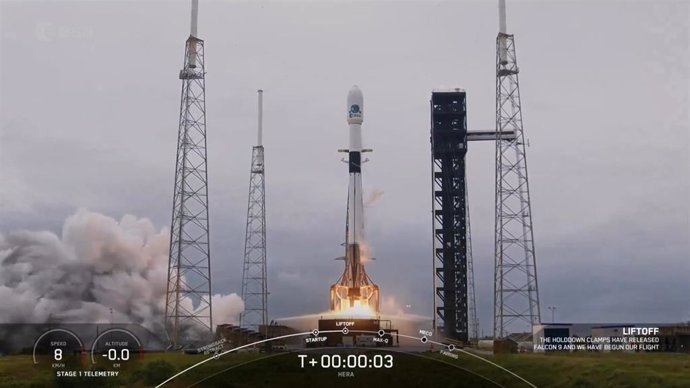911632.1.260.149.20241007175244
Oct. 7 () –
The European Space Agency (ESA) has successfully launched this Monday, October 7, the Hera space mission from the Cape Canaveral Space Force Station (Florida).
Hera’s launch was successfully carried out at 4:52 p.m. with a SpaceX Falcon 9 rocket. The mission is part of the planetary defense strategy against asteroid collisions and represents a continuation of the test carried out by NASA in September 2022, when the ‘Double Asteroid Redirection Test’ (DART) mission impacted Dimorphos to modify its orbit.
“The ESA Hera mission took off aboard a SpaceX Falcon 9 from the Cape Canaveral space station in Florida (USA) on October 7 at 10:52 local time (16:52 CEST, 14 :52 UTC), ESA announced in a publication on the social network X, collected by Europa Press.
Dimorphos was the satellite of the Didymos binary asteroid system, the first object in the Solar System whose orbit was modified by human activity. Now, as detailed by the ESA, Hera will carry out a detailed study after the impact.
The purpose is to gather crucial missing data on Dimorphos in order to understand the application limits of asteroid kinetic drift.a planetary defense technique that the DART mission has proven to be reliable.
The Planetary Sciences team, which is part of the Astronomy and Astrophysics research group at the University of Alicante (UA), has traveled to Cape Canaveral (Florida) to participate in the launch of the Hera space mission.
Adriano Campo Bagatin, from the UA, and Julia de León, from the Institute of Astrophysics of the Canary Islands (IAC), are the only researchers belonging to Spanish institutions of the thirty European scientists who make up the mission team.
The UA Planetary Sciences team has participated since the beginning of the mission in the study of the internal structure of the asteroids Didymos and Dimorphos, which form the binary system of near-Earth asteroids that is the object of the mission.
In addition, they are responsible for studying the evolution of the material that may have been launched into space as a result of the DART collision, as well as the effects of the relapse of that material on the surface of both bodies.
“We have been contributing to the preparations for this mission for years, determining, with those responsible for the instrumentation part, everything necessary to carry out the observations and measurements. Although it will only be the beginning, if the launch is successful, two years separate us from the first images of the asteroid that the Hera probe will send to Earth in 2026“, the researchers have noted.
The professionals have added that the mission will allow us to know exactly the effects of the collision, which implies “better information” on how to prepare in the future. “a mission to divert any asteroid that could impact Earth.”
“In 2029, the asteroid Apophis, about 300 meters in size, will graze planet Earth less than 32,000 kilometers from the surface,” said UA professor Adriano Campo Bagatin. “Asteroid collisions may happen again“, he concluded.


![[Img #74661]](https://thelatestnews.world/wp-content/uploads/2024/12/The-power-of-ultrasound-150x150.jpg)










![[Img #74661]](https://thelatestnews.world/wp-content/uploads/2024/12/The-power-of-ultrasound-300x200.jpg)


Add Comment